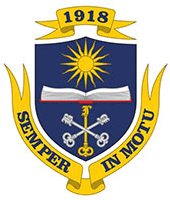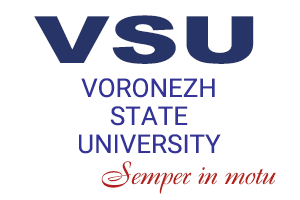Laboratories (Faculty of Geology)
- Complex Research Laboratories of the Research Institution of Geology
- Laboratory of Biostratigraphical Research
- Mineragenical and Mineralogical and Petrological Laboratories
- Mining and Petrological Laboratory
- Laboratory of Sample Preparation and Substance Analysis
- Training Laboratory of Soil Science and Soil Mechanics
- Geology, Mineralogy, Geochemistry, and Minerageny of Central Russia in the Precambrian Age
- Joint Professor A.P. Tarkov Laboratory of Deep Structure, Geodynamics, and Seismological Monitoring (VSU and Federal Research Centre of the Unified Geophysical Service of the Russian Academy of Sciences)
- Laboratory of Ecological Geology
- Academic Manufacturing Centre “Geology”
- Electrical Exploration Laboratory
- Engineering Centre “I-TECHNOLOGY”
- Laboratory of Petrophysics
Complex Research Laboratories of the Research Institution of Geology
Industrial partners
- FSFI Hydrospetsgeologia
- A.P. Karpinsky Russian Geological Research Institute (VSEGEI)
- OOO Akma-Universal
- OOO SIBELKO
Research area
Geology, hydrogeology, geo-engineering, ecology
Laboratory equipment
- Photoelectric colorimeter KFK-2-UKhL4.2
- Hanna Instruments HI 98309 pure water tester/conductivity meter
- HTR -220CE VIBRA electronic scales
- Ionometric converter I-500
- KFK-3КМ spectrophotometer
- Burette GOST 29251-91
- Densitometer (PAO Steklopribor, Chervonozavodsk)
- Combined glass electrode ESK-10601/4
- Atomic absorption spectrometer Kvant-Z.ETA-T
- Aneroid barometer BAMM-1
- Ion-selective electrode ELIS-131F
- Semi-automatic soil compactor
- Frost heave measurement device UPG-MG 4.01/H
- Laboratory ion meter I-150MI
- S8 Tiger X-ray diffractometer (Bruker AXS)
- Dial indicator ICh-10
- Glass electrode ES-10603
- Electric laboratory oven SNOL 67/350
- Muffle furnace Snol 6.7/1300
- Polarizing microscope POLAM R-312 (LOMO) (Russia)
- Binocular MBS-1 LOMO (Russia)
- Vibration analyser A 20
- Water distilling apparatus DE-4
- Titration system SM-2
- MATRIX hydraulic bottle jack
- HERZOG TP-40 pellet press
- Pycnometers
Available research methods
The methods described in standards and regulatory documents (GOST, guidelines of the Academic Council on Analytical Research methods, conversational standards PNDF, SNiP (construction rules and regulations), Sanitary Regulations and Norms, etc.)
Challenges
- Chemical analysis of water, soil, subsoils, sediment, rock formations, ores, and their by-products
- Mineralogical analysis and geotechnical investigation of subsoils
Major projects
Performing geological and groundwater public survey (1:200,000 and 1:1,000,000 scale) since 1991
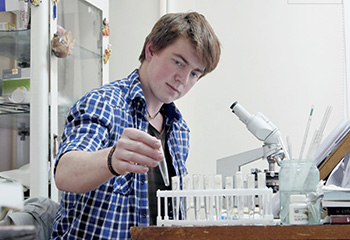 Laboratory of Biostratigraphical Research
Laboratory of Biostratigraphical Research
Industrial partners
- AO Sibirskoye PGO (Chita)
- OAO Uralskaya geologo-syomochnaya ekspeditsiya (Ekaterinburg)
- Institute of the Earth's Crust Siberian Branch of the Russian Academy of Sciences (Irkutsk)
- OAO Geokarta-Perm (Perm)
- Institute of Physicochemical and Biological Issues in Soil Studies of the Russian Academy of Sciences (Moscow, Puscheno)
Research area
Biostratigraphic criteria for chronological periodisation of sedimentary rocks from Precambrian to the Holocene
Laboratory equipment
Biological microscopes MBI-3 and R-17, with a magnification ranging from 250 to 1500
Available research methods
- Spore-and-pollen analysis (identifying Palaeozoic, Mesozoic, and Cenozoic spores and pollen)
- Diatomic analysis (identifying Cenozoic diatoms)
Challenges
Performing paleontological studies in order to determine the age of the mapped rock masses, layers and sediment units
Major projects
The laboratory was opened 60 years and and since then it has been working on various scale projects. The employees of the laboratory are highly qualified specialists.
Mineragenical and Mineralogical and Petrological Laboratories
Research area
Minerageny, mineralogy, petrography
Laboratory equipment
- Geological and outline maps
- Computer hardware and software
- Paper demonstration materials
- Olympus BX51 polarized-light microscopes
- Polam Р-312 ore microscopes
- Binoculars MBS-9;
- JEOL 6380 LV microprobe analyzer with INCA 250 energy dispersive analysis system
- S8 Tiger X-ray diffractometer (Bruker AXS GmbH, Germany)
Major projects
- Ministry of Education and Science of the Russian Federation, roadmap “Magmatism and ore-forming systems of non-ferrous and precious metals, their place in the theory of general evolution of the Precambrian lithosphere in Central Russia (assessing the resources and exploration prospects)”
- Ministry of Education and Science of the Russian Federation, Federal target programme “Academic and Teaching Staff...” 1.1 Federal target programme for the Centre for Research and Education 1.1 No. 14.V37.21.0585 “New criteria for blue earth localisation and the forecast for their localisation in the Russian territory of the East European Platform”
- Ministry of Education and Science of the Russian Federation, Federal target programme “Academic and Teaching Staff...” 1.2.1 Federal target programme 1.2.1 No. 14.V37.21.1253 “Geology and petrology of sulphide-platinoid-nickel-copper ore-forming systems in the Voronezh region, their place in the theory of general evolution of the Precambrian lithosphere in Central Russia (assessing the resources and prospects for creating Central European base for mining strategically important metals)”
- Ministry of Education and Science of the Russian Federation, Federal target programme “Academic and Teaching Staff...” 1.3.2 Federal target programme 1.3.2 No. 14.740.11.1273 “Assessing and forecasting non-ferrous and precious metals in the Lgovsky-Rakityansky greenstone belt (Central Russia, the Kursk Magnetic Anomaly)”
- Grant of the Russian Foundation for Basic Research No. 11–05–00316-а “Gold and platinum black-shale stratified Precambrian depositional sequences in the Central Russia (types, composition, genesis, resources, forecasting and integrated development techniques)”
Available research methods
- Historical geology methods of mineragenetic analysis and mapping, inluding determining tectonomagmatic cycles of each orogen and/or platform, determining the paragenetic relationships of ores and structural and compositional complexes of tectonomagmatic cycles, and separation of mineragenetic provinces and belts, and mineragenetic zones within them. Mineragenetic zones are basic small-scale spatial taxons with each tectonomagmatic cycle having its own mineragenetic zone.
- Optical diagnostics of minerals under the microscope in transmitted and reflected light
- Mineralogical analysis of rocks and ores
- Radiographical analysis
- X-ray fluorescence analysis
- Electron microprobe analysis with scanning electron microscopy
Challenges
- Mineragenetic assessment of geological features
- Conducting mineralogical analysis of black sand and crushed samples
- Determining mineral composition of rocks and ores
- Petrographic description of rocks
Mining and Petrological Laboratory, Sample Preparation and Substance Analysis Laboratory
Research area
Mineralogy, petrography, petrology, geochemistry, minerageny
Laboratory equipment
- Computer hardware and software
- Polam Р-311 polarized-light microscopes
- Polam Р-312 ore microscopes
- Roll-jaw crusher
- LDI-65 grinder
- Draft chamber
- Johnson riffles
- Sochnev magnet
- Automated line for production of thin and polished rock sections (including diamond saws and buffing and grinding wheels)
Available research methods
- Optical diagnostics of minerals under the microscope in transmitted and reflected light
- Electron microprobe analysis with scanning electron microscopy
- Mineralogical analysis of rocks and ores
- Radiographical analysis
- X-ray fluorescence analysis
- Electron microprobe analysis with scanning electron microscopy
Challenges
- Determination of mineral composition of rocks and ores
- Petrographic description of rocks
- Preparation of samples for mineralogical analysis, analysis of the chemical composition of minerals, rocks, and ores, and rock age analysis
- Preparing thin and polished rock sections, preparations for X-ray microanalysis
- Conducting mineralogical analysis of black sand and crushed samples
Major projects
- Ministry of Education and Science of the Russian Federation, geodynamics roadmap “Magmatism and ore-forming systems of non-ferrous and precious metals, their place in the theory of general evolution of the Precambrian lithosphere in Central Russia (assessing the resources and exploration prospects)”
- Ministry of Education and Science of the Russian Federation, Federal target programme “Academic and Teaching Staff...” 1.1 Federal target programme for the Centre for Research and Education 1.1 No. 14.V37.21.0585 “New criteria for blue earth localisation and the forecast for their localisation in the Russian territory of the East European Platform”
- Ministry of Education and Science of the Russian Federation, Federal target programme “Academic and Teaching Staff...” 1.2.1 Federal target programme 1.2.1 No. 14.V37.21.1253 “Geology and petrology of sulphide-platinoid-nickel-copper ore-forming systems in the Voronezh region, their place in the theory of general evolution of the Precambrian lithosphere in Central Russia (assessing the resources and prospects for creating Central European base for mining strategically important metals)”
- Ministry of Education and Science of the Russian Federation, Federal target programme “Academic and Teaching Staff...” 1.3.2 Federal target programme 1.3.2 No. 14.740.11.1273 “Assessing and forecasting non-ferrous and precious metals in the Lgovsky-Rakitnyansky greenstone belt (Central Russia, the Kursk Magnetic Anomaly)”
- Grant of the Russian Foundation for Basic Research No. 11–05–00316-а “Gold and platinum black-shale stratified Precambrian depositional sequences in Central Russia (types, composition, genesis, resources, forecasting, and integrated development techniques)”
Training Laboratory of Soil Science and Soil Mechanics
Industrial partners
- OOO AKMA-Universal
Research area
Soil science, soil mechanics, engineering structures, geocryology
Laboratory equipment
- Preconsolidation apparatus
- Box shear apparatus
- Consolidometers, stabilometer
- Compressor
- Apparatus for the determination of soil characteristics (PNG-1), apparatus for determining the free swell index of loamy soils (PNG)
- Balance
- Hydraulic press
- Metal sample containers
- Vasiliev's cone
- Areometer
- Pycnometer
- Soil shrinkage moulds
Available research methods
Laboratory study of soil properties, compression (simple and triaxial compression), shear
Challenges
- Determination of physical properties of soils
- Determination of strength properties of soils
- Determination of stress-related properties of soils
Geology, Mineralogy, Geochemistry, and Minerageny of Central Russia in the Precambrian Age
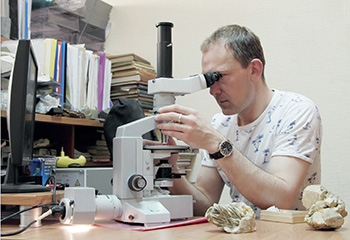 Research area
Research area
Mineralogy, petrography, petrology, geochemistry, minerageny
Laboratory equipment
- Sets of geologic and outline maps
- Computer hardware and software
- Polam Р-311 polarized-light microscopes
- Polam Р-312 ore microscopes, MBS‑9 binocular microscope
- JEOL 6380 LV microprobe analyser with a INCA 250 energy-dispersive detachable device
- S8 Tiger X-ray diffractometer (Bruker AXS GmbH, Germany).
Available research methods
- Optical diagnostics of minerals under the microscope in transmitted and reflected light
- Mineralogical analysis of rocks and ores
- Radiographical analysis
- X-ray fluorescence analysis
- Electron microprobe analysis with scanning electron microscopy
- Set of historic and geologic methods of mineralogical analysis and minerogenic mapping, including: 1) distinguishing of tectonomagmatic cycles in a specified orogen and/or platform; 2) establishing paragenetic connections in ore formations with structural and compositional complexes of tectonomagmatic cycles; 3) isolation of mineragenetic provinces and belts and mineragenetic zones they are comprised of Mineragenetic zones are designated as belonging to basic small-scale spatial taxon, which is individual for each tectonomagmatic cycle
Challenges
- Conducting mineralogical analysis of black sand and crushed samples, determining mineral composition of rocks and ores
- Petrographic description of rocks
- Mineragenetic assessment of geological features
Major projects
- Ministry of Education and Science of the Russian Federation, geodynamics roadmap “Magmatism and ore-forming systems of non-ferrous and precious metals, their place in the theory of general evolution of the Precambrian lithosphere in Central Russia (assessing the resources and exploration prospects)”
- Ministry of Education and Science of the Russian Federation, Federal target programme “Academic and Teaching Staff...” 1.1 Federal target programme for the Centre for Research and Education 1.1 No. 14.V37.21.0585 “New criteria for localisation ofdiamond-bearing kimberlites and the forecast for their localisation in the Russian territory of the East European Platform”
- Ministry of Education and Science of the Russian Federation, Federal target programme “Academic and Teaching Staff...” 1.2.1 Federal target programme 1.2.1 No. 14.V37.21.1253 “Geology and petrology of sulphide-platinoid-nickel-copper ore-forming systems in the Voronezh region, their place in the theory of general evolution of the Precambrian lithosphere in Central Russia (assessing the resources and prospects for creating Central European base for mining strategically important metals)”
- Ministry of Education and Science of the Russian Federation, Federal target programme “Academic and Teaching Staff...” 1.3.2 Federal target programme 1.3.2 No. 14.740.11.1273 “Assessing and forecasting non-ferrous and precious metals in the Lgovsky-Rakitnyansky greenstone belt (Central Russia, the Kursk Magnetic Anomaly)”
- Grant of the Russian Foundation for Basic Research No. 11–05–00316-а “Gold and platinum black-shale stratified Precambrian depositional sequences in Central Russia (types, composition, genesis, resources, forecasting, and integrated development techniques)”
Joint Professor A.P. Tarkov Laboratory of Deep Structure, Geodynamics, and Seismological Monitoring (VSU and Federal Research Centre of the Unified Geophysical Service of the Russian Academy of Sciences)
Industrial partners
- Nuclear power plants
Research area
- Seismology, seismic safety, microseismology
Laboratory equipment
- 16 seismic stations
- Recorders
- Seismometer
- 2 local servers
Available research methods
- Registration of the seismic wavefield by 16 seismic stations, five of which belong to the Federal seismic observation network in Russia
- Special methods for processing and interpretation of the wavefield
- Detection of far, regional, and local earthquakes, microearthquakes, and explosions by means of modern software
- Statistic and spectral correlation methods of processing microseismic field
Challenges
- Theoretical investigation aimed at studying nonlinear properties of geological environment, cause and effect relationships between physical-geological irregularities of the lithosphere and seismic activity of platform regions today
- Investigation of Earth’s global seismic activity
- Studying seismic activity in the central flat terrain of Russia (Central Black Earth economic region and neighbouring territories)
- Assessment of the seismic and tectonic setting in the territories with nuclear power stations (Kursk, Novovoronezh, etc.).
- Seismic microzoning of urban agglomerations, sites of high environmental sensitivity, planned or existing regions of mineral extraction
- Studying the vibration modes of the geological environment at construction sites of residential and other buildings
- Evaluation of the vibration mode of buildings and facilities, the influence of industrial explosions on building and facility sustainability
Major projects
- “Studying the nonlinear properties of the platform lithosphere based on the analysis of the microseismic field and effect of impulse actions on the geological environment (based on the example of the Voronezh crystalline massif) (2009–2011)
- “Studying lithospheric and ionospheric relationships in the area of the Voronezh crystalline massif” (2013–2015)
Laboratory of Ecological Geology
Industrial partners
- Department of Natural Resources and Ecology of specific regions of the Russian Federation
- OOO EKO SPETS STROI (Voronezh)
- ZAO Krasnoye znamya (Voronezh)
- OOO ProektGenStroi (Voronezh)
- OOO ARST (Moscow)
Research area
- Engineering site investigations for construction
- Ecological and geological research of technology-intensive territories
- Ecological modelling and environmental design
Available research methods
- Spectrometric (photometric) method
- Titration-based method
- Potentiometric method
Challenges
- Analytical investigation of soils, terrains, and subterranean waters
- Ecological and geological mapping
- Forecasting effects of specified features on environmental components
- Monitoring environmental components
- Ecological modelling
- Environmental design
- Innovation technologies in environmental education
Laboratory equipment
- SHVk-1200 draft chamber
- SESH-3М dewatering box
- AE-14-”YA-FP” water distilling apparatus
- I-130 laboratory ionomer
- ANION-7000 portable рН‑meter
- KFK-2-UHL 4.2 photoelectric concentration colorimeter
- Visocolor ECO, HE test-kits
- ADAM HCB-123 laboratory balance
- Electronic Balance HX3001-T
- RKS107 dosimeter-radiometer
- PGA-1 gas analyser
- Testo 816–1 digital sound level meter
Major projects
- Monitoring ground water contamination with petroleum on the premises of a large oil tank farm in Voronezh
- Estimation of flooding areas in the Voronezh region
- Geotechnical exploring for construction in the Voronezh region and neighbouring regions
- Monitoring of exogenetic processes in the Lipetsk region
- Ecological hydrogeochemical monitoring of underground waters in specified districts of the Voronezh, Moscow, Belgorod, Kaliningrad, and Tver regions
- Development of the system of specially protected territories
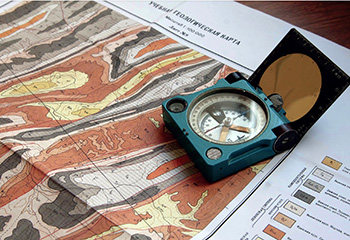 Academic Manufacturing Centre “Geology”
Academic Manufacturing Centre “Geology”
Research area
Deep structure of the Earth's crust, geodynamics, magma generation and deposit generation, and accumulation conditions in the Precambrian in platform sedimentary basins and fold belts
Laboratory equipment
- Altami СМ0745 Greenough-type stereo microscope providing three-dimensional picture in reflected light
- BiOptic BPR-100-series polarised-light microscope
Available research methods
Mineralogical and petrological methods
Challenges
- Conducting basic research in geology
- Carrying out applied works based on the results of the basic research
- Mineralogical and petrological analysis of rocks
Major projects
- Studying the deep structure and evolution of the crystalline basement and the sedimentary cover of the lithosphere in the Voronezh crystalline core-area by means of comprehensive modelling
- Studying the evolution of the sedimentary cover and titan-zirconium placer formation in the Voronezh anteclise by means of paleogeographic and lithologic-and-facies modelling
- Development of innovative principles for assessing the resource potential of the Voronezh anticlise
- Studying structural, lithologic, and mineralogical criteria of enhancing resources potential and investment attractiveness of titan-zirconium placers of the Voronezh anticlise
- Studying the lithology and material composition of titanium-zirconium sands to enhance complex extraction of major and minor components at the Eastern area of the Central Field
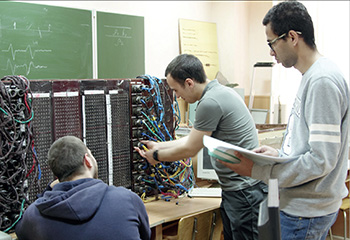 Electrical Exploration Laboratory
Electrical Exploration Laboratory
Industrial partners
- OAO Geotechnologia
- OOO AKMA-Universal
Research area
Geophysics and geophysical methods in mineral deposit exploration
Laboratory equipment
- Tanks for physical modelling of electro exploring tasks – 3
- Electrical exploration equipment – 6 sets
- Computers
Challenges
- Conducting field observations
- Interpretation of geoelectrophysical research materials
Available research methods
- Geoelectrical research by resistance and provoked polarisation technique
- Analogue modelling of electro exploring tasks in complex environments
Major projects
Nickel and gold deposit exploration in Primorye, the Kamchatka, and Northern Urals
Engineering Centre “I-TECHNOLOGY”
Industrial partners
- OOO TSKIG “TSITRIN”
- OOO Gidrosfera
- AO Primorzoloto
Research area
Processing technology for enriched tailings of common mineral resources
Laboratory equipment
- Spiral separators
- Magnetic separators
- Concentrating tables
- Shaker screen
Available research methods
- Mineralogical analysis
- Granulometric analysis
- Petrological analysis
Challenges
- Studying mineral raw materials for cost-efficiency of their processing
- Development of technological flows for processing of minerals
Major projects
- “Studying the lithology and material composition of titanium-zirconium sands to enhance complex extraction of major and minor components at the Eastern area of the Central Field” (2012–2014)
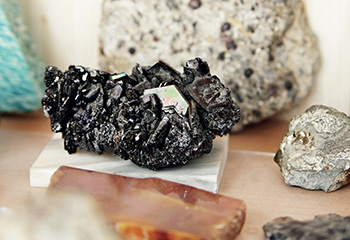 Laboratory of Petrophysics
Laboratory of Petrophysics
Industrial partners
- AO OT-OIL
- OOO AKMA-Universal
Research area
Geophysical research of the Earth's crust and mineral deposit exploration
Laboratory equipment
- Measuring devices for magnetic properties of rocks and ores
- Densitometer
- Seismic-wave velocity meter
- Measuring device for electrical properties of rocks
- Computers with a multimedia system
Major projects
Studying physical properties of sedimentary and crystalline rocks in Primorye, the Kamchatka, Northern Urals, and Central districts of the Russian Federation
Available research methods
Petrophysical investigations of specimens of rocks and ores
Challenges
- Conducting field observations
- Interpretation of geophysical research materials
Voronezh State University • 1997–2025
